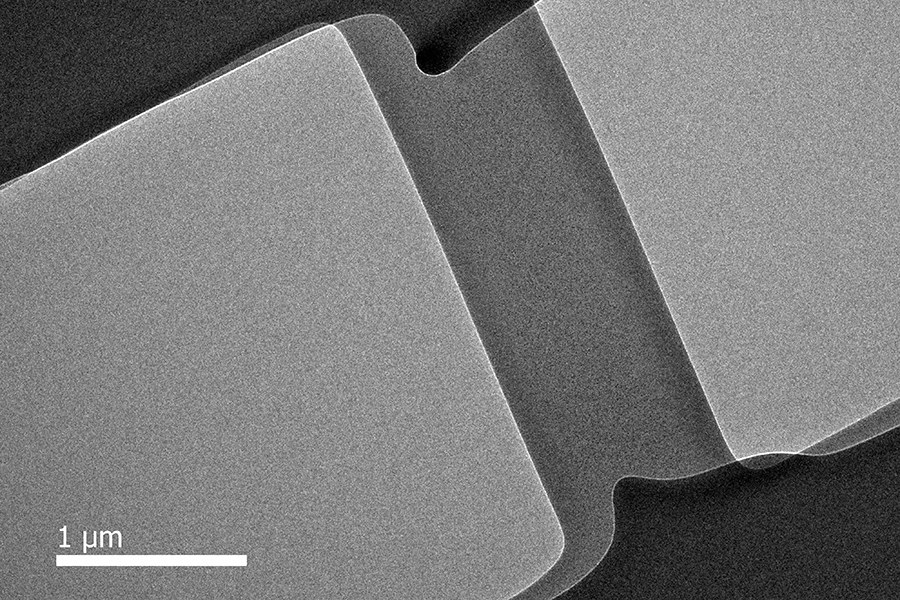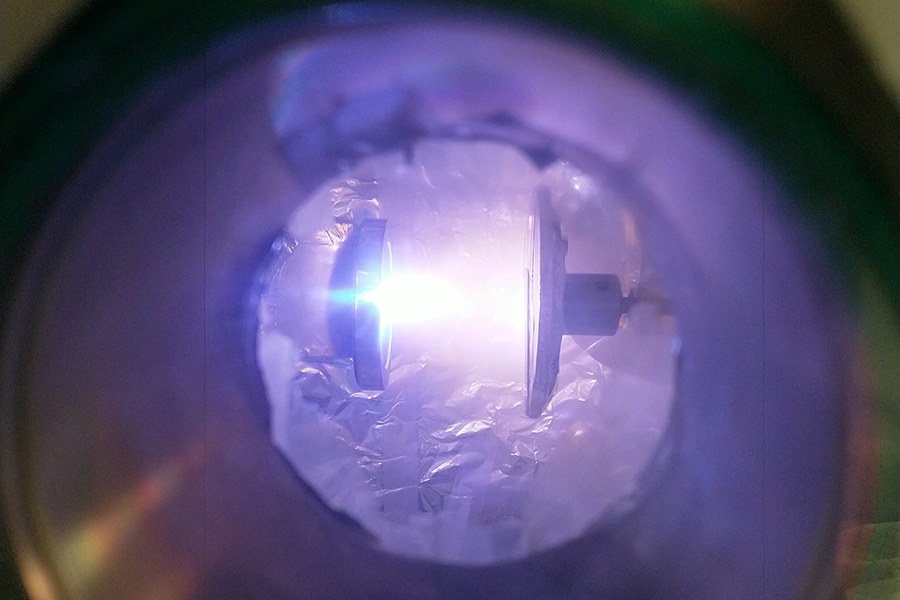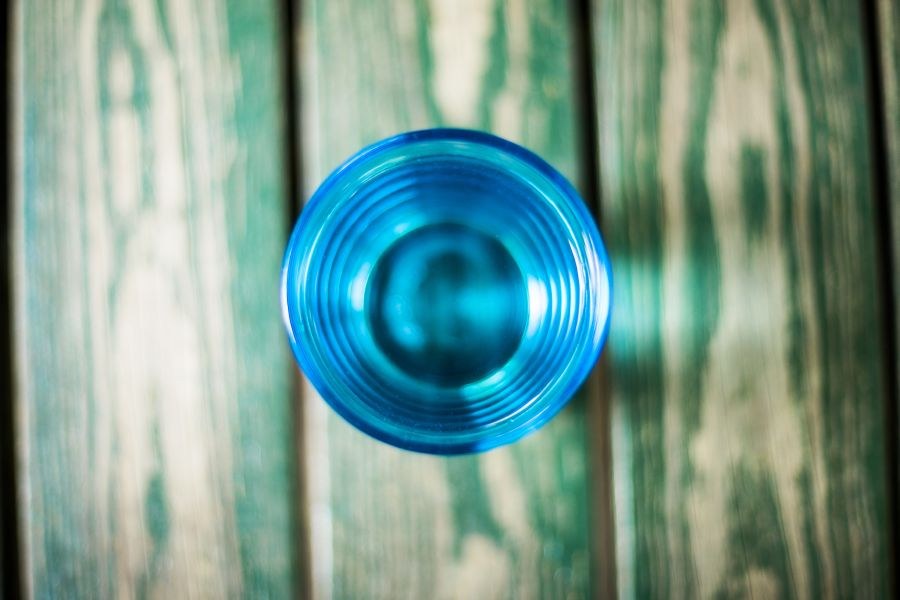Ductile glass bends instead of breaking

The new type of glass exhibits metal-like properties and, as opposed to conventional glass, is ductile when stretched or compressed. The results were published 15th of November 2019 in the prestigious Science Magazine. (Frankberg et al. Highly ductile amorphous oxide at room temperature and high strain rate, Science 2019. The link will start working on 15.11.2019)
“Conventional glass is brittle and easily shatters under pressure. We discovered a way to manufacture glass that exhibits ductile behaviour. In other words, our glass is tougher than conventional glass,” says Marie Curie Fellow Dr. Erkka Frankberg.
The researchers used a challenging technique called pulsed laser deposition to convert aluminium oxide into a glass-like state.
“It is exceedingly difficult to convert aluminium oxide into a glassy substance. The traditional glass manufacturing processes cannot be applied to aluminium oxide because it easily transforms into the crystalline form. The solution is to cool the material down extremely fast from a high temperature to prevent crystallization,” Frankberg describes.

The fabrication of a glass that exhibits plasticity is extremely challenging. According to Frankberg, the process must be further refined and developed before the new type of glass can be manufactured on a larger scale.
“Both aluminium and oxygen are abundant on Earth, but we require an unconventional manufacturing process to achieve the desired properties. The produced glass also needs to be sufficiently pure and flawless which presents a further challenge,” Frankberg says.
A high quality glass material is mandatory for the ductility. The presence of any imperfections in the glass, such as cracks, bubbles or impurities, may result in fracture.
The glass is ductile because atoms are able to move and change places
Conventional flat glass is primarily made up of silicon oxide and cracks easily because the atoms in the glass are not able to move when subjected to stress. If the glass is bent or stretched too hard, it will break. Traditional glass manufacturing processes allow glass to moulded into any shape, but they require a high temperature.
“In the traditional process, glass is heated to a molten state. I am sure we have all seen glass blowers handling red-hot glass,” Frankberg says.

The demonstrated glass ductility is however achieved at room temperature.
“In our glass, the atoms are able to move from one location to another before the glass reaches the stress needed for fracture, whereas in conventional glass the fracture stress is achieved before the atoms begin to move, which is why the glass breaks easily.”
But surely any material will eventually break when it is subjected to continuously increasing stress?
“Well, yes and no. In a brittle material, stress will steadily build up until it fractures. If the atoms however begin to move before the fracture stress is reached, the stress will no longer increase but levels off to a yield stress, creating a continuous phenomenon,” Frankberg describes.

Looking for other glasses that exhibit plasticity
The researchers prepared thin films of their glass and subjected them to mechanical stress. Although the material exhibits metal-like properties, it is still glass.
“We stretched and compressed samples of our material. By carrying out combined compression and shear tests, we were able to demonstrate that the material is also capable of adjusting to a shear force”, Frankberg says.
The main experiments were performed using a specialized test equipment placed inside a transmission electron microscope housed in Lyon, France. The international research consortium comprised of researchers from Finland, France, Italy, Austria, Norway and USA.
“Researchers from Tampere University carried out the extensive computational modelling required for the study. We utilised the supercomputers Sisu and Taito located in the IT Center for Science (CSC) in Kajaani, Finland, to create atomic-scale models of the new material. In addition, the equipment housed in the new Tampere Microscopy Center (TMC) were utilised in the experimental part of the project. Building up the challenging experimental setup required a strong international effort from experts from diverse fields of Materials Science.”, says Frankberg, who led the research consortium.
The research project has received national funding from Finland, France and Italy and international funding from the European Union under the Horizon 2020 Research Programme. However, the research is still in its early stages.
“Demonstrating the ductility is only the beginning. Next we will investigate which other glasses have the same ability and why some glasses remain brittle”, Frankberg says.

New applications for glass
A glass that is capable of plastic deformation may open up new avenues for innovation.
“Glass is a common household material but has limited uses due to its intrinsic brittleness. Our research may help to identify new areas of application for glass”, Frankberg says.
There is great demand for more durable glass, which, for example, in smartphones would prevent the screen from breaking if the phone is dropped on a hard floor.
“You might be able to smash your phone on the floor without breaking the screen. Our current smartphone screens are basically regular window glass with enhanced elasticity and strength. But they are still ultimately made out of glass that exhibits no plastic behaviour,” Frankberg points out.
It may also be possible to develop new glass-based innovations by looking in unexpected directions. We may not be able to open our mind to the world of possibilities offered by new types of glass because we inherently associate glass with brittleness. Glass that is considerably tougher than ordinary glass would have great potential for new applications.
“Surprisingly little is known about glass materials. This study increases our understanding and opens up whole new research avenues,” Frankberg says.
The new type of glass is much stronger than steel. As glass is also much lighter than steel, the new material may have potential uses, for example, in mechanical engineering and construction. Modern applications of glass are often hidden from plain sight in electronics, renewable energy production systems, space applications and battery technologies. The level of durability achieved by the researchers may open up new perspectives for research on a broad range of technologies.
“Still, research takes time. Now that we have made the discovery, it will likely take decades before production can be scaled up to industrial proportions. This is often the case in materials engineering. But if a material is genuinely useful for humanity, it will end up being used for thousands of years – as glass has been,” Frankberg says.
Text: Jaakko Kinnunen
Pictures: Jonne Renvall & Erkka Frankberg





